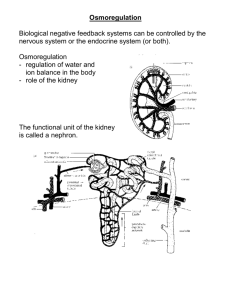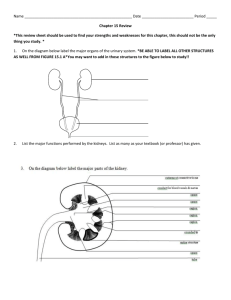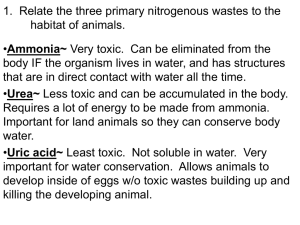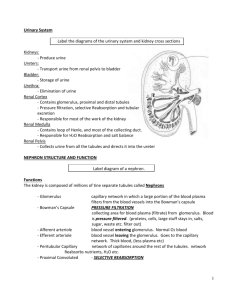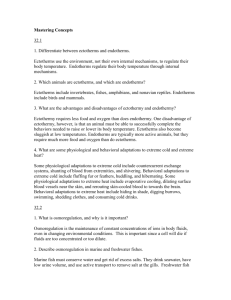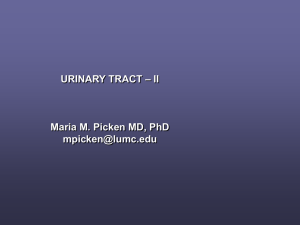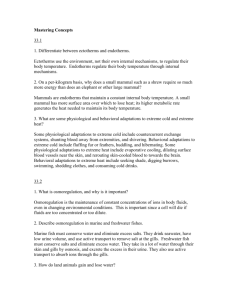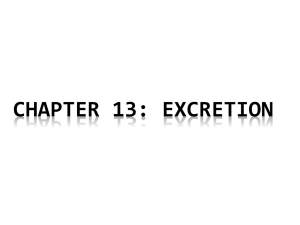Blood Supply to the Nephron
advertisement
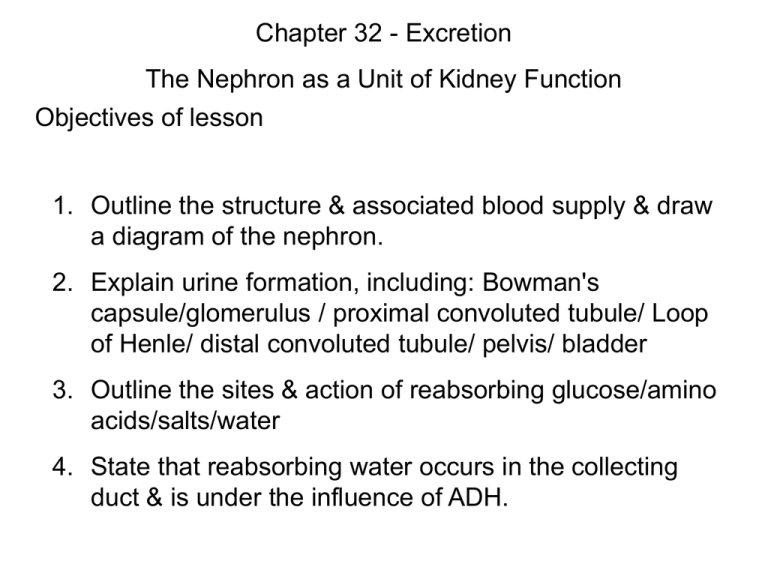
Chapter 32 - Excretion The Nephron as a Unit of Kidney Function Objectives of lesson 1. Outline the structure & associated blood supply & draw a diagram of the nephron. 2. Explain urine formation, including: Bowman's capsule/glomerulus / proximal convoluted tubule/ Loop of Henle/ distal convoluted tubule/ pelvis/ bladder 3. Outline the sites & action of reabsorbing glucose/amino acids/salts/water 4. State that reabsorbing water occurs in the collecting duct & is under the influence of ADH. Each kidney contains more than a million nephrons. A nephron is a tube about 3cm long located in the cortex and medula of the kidney A section through the kidney shows an outer darker region (cortex) and a lighter inner zone (medulla). Pelvis Cortex Medulla Ureter The Nephron is the functional unit of the kidney Blood Supply to the Nephron Blood enters kidney through renal artery. This blood vessel divides to form the renal arterioles which split further to form afferent (incoming) arterioles. Each afferent arteriole splits further to form a cluster of capillaries called the glomerulus. The glomerulus fits into the Bowman’s Capsule which is a cup shaped structure. Blood leaves the glomerulus through the efferent (outgoing) arteriole. This then divides to form capillariers that surround the rest of the nephron. The capillaries eventually rejoin to form renal venules that emerge from the kidney as the renal vein NEPHRON 1. Filtration Filtration means that water and small molecules pass (under high pressure) from the blood into the nephron. a) The renal artery divides into afferent arterioles and then into a capillary network (glomerulus) at the top of each nephron. b) A cup-shaped funnel (Bowman’s capsule) surrounds each glomerulus and it is here that smaller molecules in the blood are forced, under pressure, out of the plasma and into the lumen of Bowman’s capsule, forming the glomerular filtrate. c) The blood pressure is high because the efferent arteriole is narrower than the afferent arteriole, so force-filtering the plasma. d) Everything (glucose, vitamins, urea, water etc) except large proteins and blood cells gets filtered. About 180L of glomerular filtrate are formed every 24 hours This is 4.5 times the fluid content of the body. Not all this liquid leaves the body as urine 2. Reabsorption Reabsorption means that molecules pass from the nephron back into the blood. a) The body cannot afford to lose useful chemicals like food and water, so as the glomerular filtrate passes from the Bowman's capsule into the proximal convoluted tubule, glucose, amino acids, some salts and water are reabsorbed back into the blood. b) The food molecules, including most of the salt ions, are taken back by active transport (against the concentration gradient, so energy is needed for this). Most of the water is reabsorbed by osmosis— from the Loop of Henle and convoluted tubules. (Active transport means that energy (in the form of ATP) is used to move molecules often against a concentration gradient) i.e. from low to high concentrations 3. Secretion Secretion means that some substances pass from the blood into the nephron. Secretion of Potassium ions and hydrogen ins into the distal convoluted (highly folded) tubule help maintain the pH of the blood. Urea and other wastes, along with some water, are not reabsorbed. They pass, as urine, into the pelvis of the kidney and to the bladder for storage. Of the 180L of blood filtered each day, about 99 % of the filtrate is reabsorbed. Urine Consists of: 96% water 2.5% nitrogenous waste (mostly urea) 1.5% salts Urea is produced in the liver when excess proteins are broken down (de-animation) Functions of the regions of the nephron Region Substance reabsorbed Amount of water reabsorbed Proximal convoluted tubule Most salts, glucose, amino acids & vitamins most Loop of henle (decending limb) Some minerals A little Loop of henle (ascending limb) Some salts none Distal convoluted tubule Some salts some Collecting duct None A little Quiz • • • • • • • Name the parts of the nephron Where does filtration takes place? What does not get filtered Where does reabsorption take place? What substances are reabsorbed? What are not reabsorbed? List some substances present in urine. The kidney regulates the amount of water in the body by varying the amount of urine produced. This is known as osmoregulation, and it is an example of homeostasis. ADH [Anti-diuretic hormone] controls whether the distal tubule and collecting ducts reabsorb water or not. If you drink a great deal of water the hypothalamus in the brain detects the diluted blood and turns off ADH production. Less water is reabsorbed, so more water is allowed to escape to the bladder, and a larger volume of dilute urine is produced. When the body is low on water ADH is secreted from the pituitary gland. More water is reabsorbed and only a small volume of urine is produced. When the body has excess water, ADH is NOT secreted from the pituitary gland. Less water is reabsorbed and so a larger volume of urine is produced. If Water Levels Rise in the Body ….. When the body is low on water, ADH is secreted from the pituitary gland. More water is reabsorbed and only a small volume of urine is produced. If Water Levels Fall in the Body….. Conditions Effect on blood Thirsty/ salty diet/ hot day/exercise/ sweating Low water Released content and high salt conc. More permeable to water Low vol of water & higher salt conc. (low vol of concentrated urine High water content & low salt conc Less permeable to water High vol of water & lower salt conc (a high vol of dilute urine) Excessive water intake/very low salt diet High protein diet ADH Not released Distal tubule Urine and collecting duct Normal No effect No effect watercontent and increased conc of urine Same vol of water, increased urea conc. (i.e. the same vol of conc urine Quiz • What is ADH? • Where is it made and where does it act? • Explain what happens in a nephron where we take in a lot of fluid. • Explain what happens in each nephron when we have not taken in fluid for many hours.


